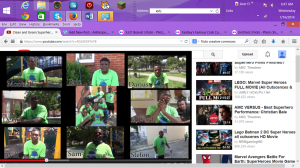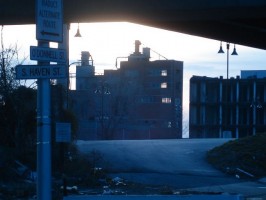My colleague, Matthew Durington, and I have just finished our final iteration of a 4-year collaborative project, Anthropology By the Wire. From the outset, we sought to produce

YouTube Video from this year’s Anthropology By the Wire, “Clean and Green Superheroes”. Photo courtesy Samuel Collins
counter-narratives to David Simon’s “The Wire,” alternative representations that contest urban imaginaries of Baltimore premised on crime and drugs. Through collaborative productions shared through social media, we have tried to challenge the directionality of these representational regimes by making local media disseminated on YouTube, Tumblr and Flickr.
But what we have realized is that the urban imaginary (as LiPuma and Koelbedescribe it), is constituted not only by representations of urban circulation, but the imagination of the circulation of those representations of circulation (and it may be circulations all the way down). In other words, it is not only the representations of the city that allow people to understand themselves and others, but the way people imagine that those representations circulate.
As mass media, “The Wire” (and other television and film evocations of the city) is imagined to circulate through an audience: a mass that desires and consumes media, that can be characterized by demographic analyses, and that, finally, can be packaged and sold to advertisers. It’s the imagined gaze of that homogeneous “mass” that has been so devastatingly effective in slotting Baltimore as “Other”: as a racial and class alterity that becomes the subject for critique and intervention.
In many ways, this idea of mass audience has been profoundly challenged by the widespread adoption of social media; to some media scholars, we are all “prosumers” now. But the social media platforms that communicate our work draw upon other circulation imaginaries.
The Spectacle City
The first is an extension of the flanerie that marked the city as a site of male privilege a la Charles Baudelaire. In the postmodern logic of late capitalism, this means the city as an extension of individual identity. In his prescient Soft City (1974), the writer Jonathan Raban put it best: “Decide who you are, and the city will again assume a fixed form around you.” In other words, the city exists as a foil for the elaboration and construction of one’s identity. Raban’s Soft City is echoed in countless films (Ferris Bueller’s Day Off) and endless postmodern spectacle, where the city becomes a site for personal consumption and successive elaborations of commodified identity.
Social media has been erected on this capitalist scaffolding. First, social media is ultimately personal social media—the city as an object for individual consumption on instagram and pinterest. With social media, life may be constituted as “an immense accumulation of spectacles” (a la Guy Debord), but those representations are inward-focused, with the spectacle of the city laid out as a buffet of representations to take and share with a circle of intimates: pictures of lunch and dinner, of urban desolation, street festivals, alternative fashion. Superficially ethnographic, each of these images and videos are mobilized as a projection of self to a cluster of acquaintances.
The Contagious City
Alongside the privileged flanerie of the 19th century city came panics over pollution and contagion, with the 1864 Contagious Disease Act targeting the poor and dissolute as sources of “pollution” to the flanerie of upper-class men. Today, theories of “contagion” are deployed epidemiologically, but they are also utilized to represent the spread of information in networks, the spread of crime in cities (the “broken window” theory) and in the virality of social media.
In each case, the question of contagion becomes a network problem. In any cascade of information, disease, new technologies, new ideas, what percent of a given social network configuration needs to be “infected” before it can spread to the remainder? When media go viral, they have passed this cascading “tipping point,” and a number of network scholars are currently examining the morphology of networks for clues to the virality of content.
Although contagion seems like the opposite of the individuated consumption of the city, it is really its logical counterpart, with each individual first atomized into her own media telecocoon before influencing her neighbors. It’s not by mistake that zombies have become such a ubiquitous figure in social apps and movies about the city. If I imagine myself as active in my individualized consumption of the spectacle of the city, than everyone else can only be a zombie, a node through which my influence propagates. In other words, as a form of circulation, we imagine social media to be composed of individuals and zombies: people who tweet, and people who propagate that tweet.
For our social media circulation of Baltimore, we therefore imagine not only media producers (those who represent Baltimore and share their representations on social media), “consumers” (those who watch the media we’ve produced), but also this interstitial category of social media zombies that pass along the links to our YouTube media and blog posts—who do the work of network propagation. In this respect, much of our social media tagging can be considered varied forms of zombie food: keywords that encourage re-posting and that stimulate networked cascades. Tagging your photo “urban ghetto” precipitates one form of contagion, while tagging the same shot “gentrification and abandonment” generates quite another. Yet these lines of contagion are only possible in the imagined circulation of individual consumption and, in the end, we need to be mindful of our zombies lest they overtake us altogether.
The Ends of the Urban Imaginary
The last scene of Akira shows Tetsuo exploding out of his body with tendrils of flesh and machine. Often interpreted as an apocalyptic, nuclear vision of Tokyo, it is simultaneously one where the differences between people and between places are eviscerated: Tetsuo’s monstrous appendages engulf his friends and enemies, traduce geographies, brachiate uncontrollably through Tokyo.
For me, Akira is a metaphor for the limits of our imaginaries of circulation. It’s the ends of these two imaginaries—the individual spectacle and the contagious zombie—pushed to their limits until social media itself has become something monstrous where the city, the individual and the community disappear into circulatory flows. In these scenarios, new configurations of the circulatory imaginary implode into non-representation. Do we have an alternative? Ultimately, our efforts to replace one circulatory imaginary with another—as Bruno Latour and Marilyn Strathern have shown—will ultimately produce more monstrous imaginaries. Who will save us from our zombies then?
(Second photograph courtesy Kamau Collins; Third photo courtesy jpellgen; Fourth photo courtesy Nick Hall)
[Originally Published in Anthropology News]



No comments:
Post a Comment